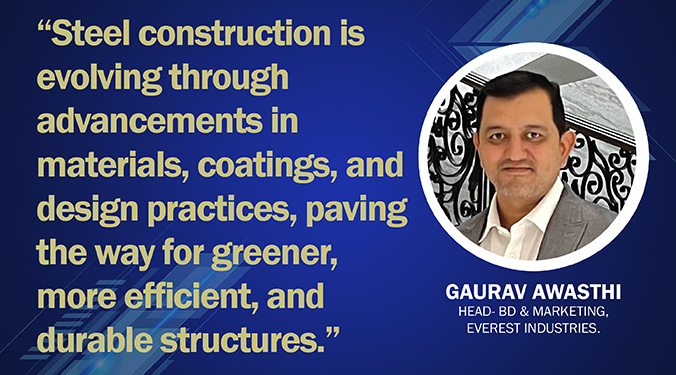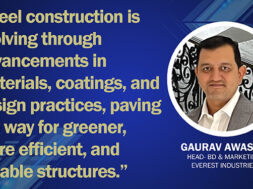Everest harnessing the full power of steel structures

Gaurav Awasthi, Head of BD & Marketing, Everest Industries, discuss the recent advancements in steel structures to ensure strength, stability, and safety.
What are the emerging trends or technologies in the field of steel structures?
The steel structures industry is witnessing some interesting trends. There is a growing emphasis on sustainable practices for constructing energy-efficient building systems by incorporating materials like innovative thermal insulation coatings and corrosion-resistant paints to enhance steel structures’ durability and longevity. The industry also adopts modular construction techniques for infrastructure projects as they significantly reduce timelines and costs. These trends collectively contribute to the steel construction industry’s continuous evolution and advancement.
Can you discuss recent advancements or innovations in steel structures that have improved their performance or sustainability?
There are notable advancements in steel structures. The development of high-strength steel grades for enhanced structural performance allows for lighter and more efficient designs. Advanced coatings and corrosion protection systems offer better resistance against environmental factors such as corrosion, rust, and weathering. Moreover, there has been an increased emphasis on recycling and reusing steel materials with advancements in steel recycling techniques. Overall, these advancements and innovations make steel construction greener and more sustainable by reducing environmental impact and optimising resource utilisation.
What are the key considerations in designing steel structures to ensure strength, stability, and safety?
Designing steel structures to ensure strength and stability requires careful consideration of several key factors. These include optimum design and thorough analysis of the structures, selection of appropriate materials considering the type and location of the building, ensuring the durability of the structure by applying appropriate coatings such as anti-corrosive and fire protection coatings, taking into account the constructability of the steel structure during the design phase to ensure ease of fabrication, transportation, and erection of steel members, and complying with relevant building codes and industry standards for safe and code-compliant steel structures. All these factors contribute to the overall efficiency, quality, and safety of the construction process. By carefully addressing these key factors; engineers can design steel structures that possess the necessary strength, stability, and safety to withstand anticipated loads and ensure the well-being of occupants and longevity of the structure.
How does steel contribute to sustainable construction practices, such as recycling, energy efficiency, or reduced carbon emissions?
Steel structures can contribute to energy efficiency in several ways. Steel’s high strength-to-weight ratio, efficient transportation, easier on-site assembly, and flexibility and adaptability for modification, expansion, and repurposing of buildings reduce energy consumption throughout the lifespan of the building.
Steel production is making significant strides in reducing its carbon footprint. Modern steel manufacturing processes employ energy-efficient technologies, use renewable energy sources, and utilise recycled steel, reducing energy consumption and greenhouse gas emissions. Steel’s recyclability, energy efficiency, reduced carbon emissions, durability, and adaptability make it a sustainable building material.
What are some common challenges or limitations when designing and constructing steel structures, and how are they typically addressed?
Designing and constructing steel structures come with certain challenges and limitations. Challenges such as design complexity due to complex loading systems can be addressed through open discussions with all project stakeholders and adequate research. Site limitations, such as restricted access, limited space, or uneven terrain, can pose challenges during construction. These challenges can be overcome through careful planning, including detailed site surveys, logistics planning, and effective coordination between the design team and construction personnel. Steel structures may be exposed to corrosive environments, requiring appropriate corrosion protection measures. Protective coatings and regular inspection and maintenance of the coatings are essential to ensure long-term corrosion resistance. All these challenges can be solved through collaborative design and careful planning.
How do advancements in computer-aided design and simulation tools impact the design and analysis of steel structures?
Integrating digital technologies, such as Computer-Aided Design (CAD) software, has dramatically impacted steel structures’ design and construction processes. These tools enable more accurate modelling, analysis, and optimisation of building designs, resulting in improved efficiency, reduced waste, and enhanced overall performance. These tools have become indispensable in the steel construction industry, empowering engineers to push the boundaries of innovation and achieve safer, more sustainable structures.
for more info visit : https://www.everestind.com/
Cookie Consent
We use cookies to personalize your experience. By continuing to visit this website you agree to our Terms & Conditions, Privacy Policy and Cookie Policy.










